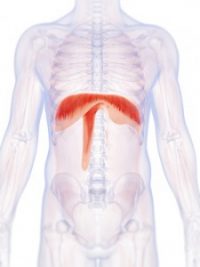
This article deals with damage to the phrenic nerve as well as treatment options. To skip directly to the treatment options, please click here.
The phrenic nerve may not be something you have heard of before, but as you read this, it is keeping you alive. This nerve controls the diaphragm muscle, which controls the breathing process. When the diaphragm contracts, the chest cavity expands and creates room for inhaled air. Breathing is an involuntary action and something you don’t have to think about. The brain’s respiratory centers and phrenic nerve function to carry out this process without you having to command your body to do so. When the phrenic nerve is damaged, it can prevent the normal breathing processes and impact your health. Fortunately, treatments exist to remedy the condition.
WHAT IS THE PHRENIC NERVE?
The phrenic nerve is actually a twin nerve, with one on the left side and one on the right of the diaphragm. The nerves serve to receive and send signals between the brain and the diaphragm. Breathing is an interesting bodily process because although you usually do not have to think about doing it, you do have the ability to hold your breath or to take a deep breath. When the nerve is damaged, this ability is lost.
WHERE IS THE PHRENIC NERVE?
The two nerves originate in the neck, go through the chest and terminate in the diaphragm. . Because of its location and proximity to both the lungs and the heart, the nerve can be impacted if there are specific conditions in either of these organs. If either of the nerves is damaged and signals between the brain and diaphragm are interrupted, normal breathing may be prevented.
CAUSES OF PHRENIC NERVE DAMAGE
If the phrenic nerve is damaged, it ceases to function normally. This can happen for a number of reasons, depending on the patient’s medical history. There are few diseases that specifically damage the phrenic nerve, though it is more common for there to be systemic problem with nerves that also impacts the phrenic nerve, than a specific disease that impacts it. If the nerve is damaged, difficulty in breathing is a common symptom, as well as a shortness of breath when lying flat. Some of the common causes of phrenic nerve damage include:
- Spinal cord injury: Depending on which vertebrae are damaged, nerve impulses can be disrupted. It is more likely if the injury occurs above the third vertebrae. If the injury is lower in the spine, breathing is usually not impacted.
- Physical trauma
- Neck injury, as related to above
- Surgical complications or trauma
- Up to 10% of cases of phrenic nerve damage are caused by operative trauma
- Because of its location, damage can unintentionally occur during heart or chest surgery
WHAT ARE THE SYMPTOMS OF PHRENIC NERVE DAMAGE?
The symptoms are varied, depending on whether the left or right nerve is damaged. If only one nerve is damaged, the patient will continue to breathe, though it will be labored. If both nerves are damaged, it becomes medically urgent, as you can no longer breathe on your own. Other symptoms include:
- Problems with the hiccups. The hiccup reflex can be triggered by phrenic nerve irritation, making the diaphragm contract abnormally, resulting in a small intake of air.
- The most severe impact of phrenic nerve damage is diaphragm paralysis, which prevents the patient from being able to regulate breathing on his or her own.
Fortunately, treatment exists for damage, though treatments vary depending on the severity and presentation.
TREATMENT FOR PHRENIC NERVE DAMAGE AND DIAPHRAGM PARALYSIS
As breathing regulation is the main symptom of phrenic nerve damage, it is crucial that the solution reinstates a normal breathing pattern and enables the subconscious process of breathing. When the heart beats irregularly, patients get a pacemaker to normalize the beat. A similar concept is used for patients who have phrenic nerve damage.
Though each patient has an individual set of conditions and treatment plan, those who are eligible may utilize the Avery Diaphragm Pacing System System, the only diaphragm pacing system with full pre-market approval from the USFDA and CE marking privileges under the European Active Implantable Medical Device Directive for both adult and pediatric use. The pacemaker may also be used for patients suffering from Central Sleep Apnea (either congenital or acquired), and diaphragm paralysis.
The pacemaker works by stimulating the phrenic nerve. The stimulator is surgically implanted with the surgeon placing an electrode under the phrenic nerve. Patients can receive one or two implants, depending on whether one or both nerves are damaged. Next, the surgeon implants a receiver just under the skin. The receivers convert the radio waves into electrical pulses that are sent down the electrodes to the phrenic nerves, causing the diaphragm to contract. The surgery itself is typically performed in less than four hours, and the patient is usually discharged after one or two days. Depending on the patient’s presenting symptoms and medical history, surgery can sometimes be performed in an outpatient setting, or under monitored (not general) anesthesia.
The diaphragm pacing system Avery offers has been implanted in over 2,000 patients in countries around the world. It is an effective option for patients who need assistance with breathing, arguably one of the most important tasks the body performs.
Content reviewed July, 2024 by Dr. Don Headley, M.D.
Dr. Headley is an otolaryngologist (ENT) with almost 40 years of experience in medicine. He is a graduate of George Washington University School of Medicine and Health Science, has been affiliated with St. Joseph’s Hospital and Medical Center in Phoenix, Arizona, and previously served as assistant professor of Internal Medicine and Surgery and Creighton University Medical School in Omaha, NE.



